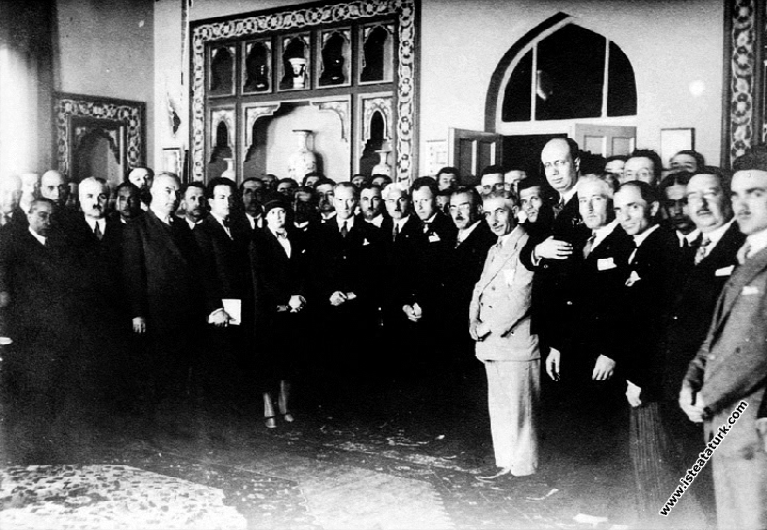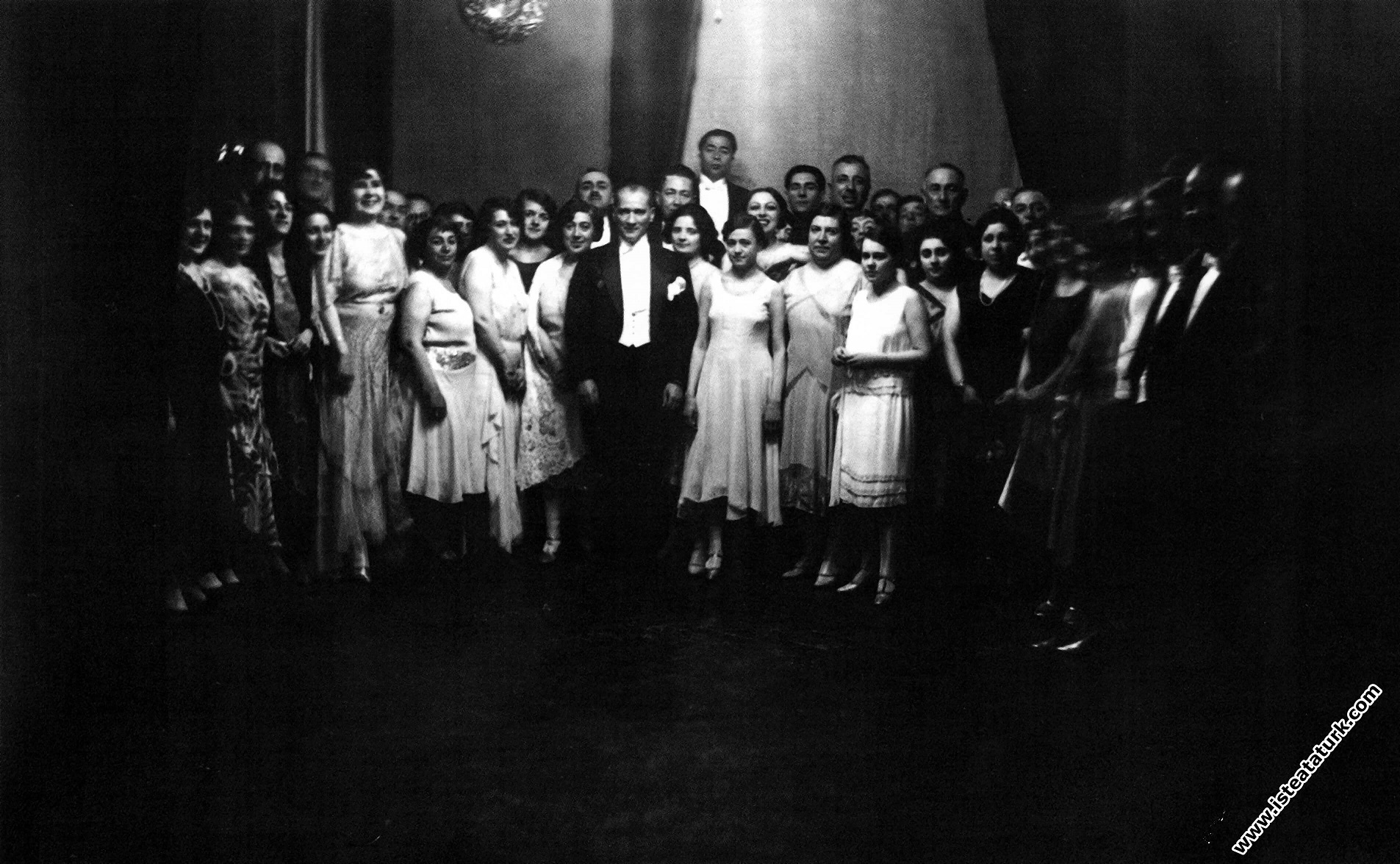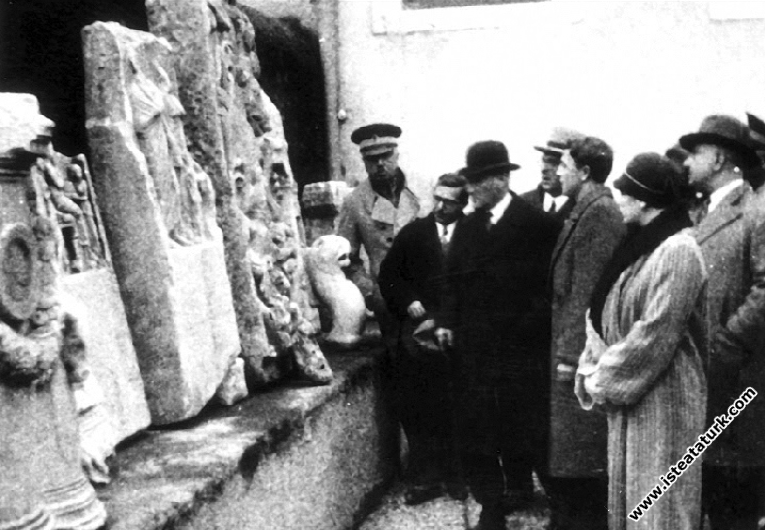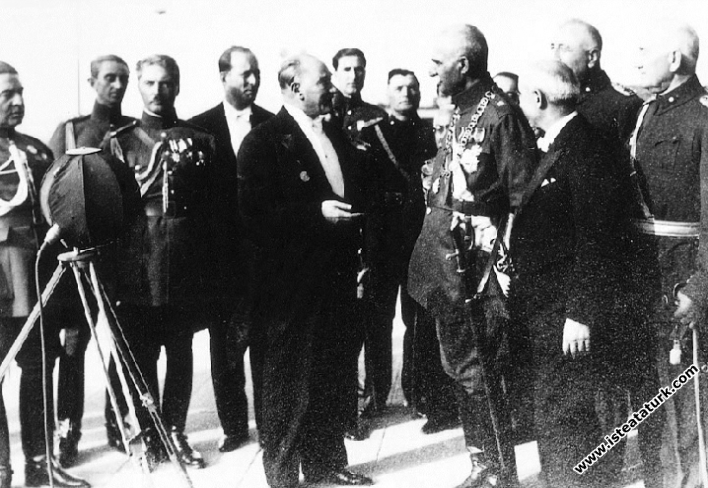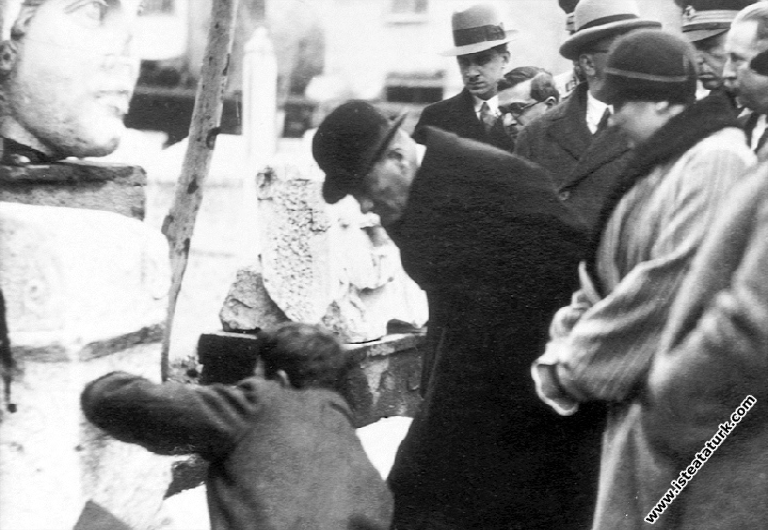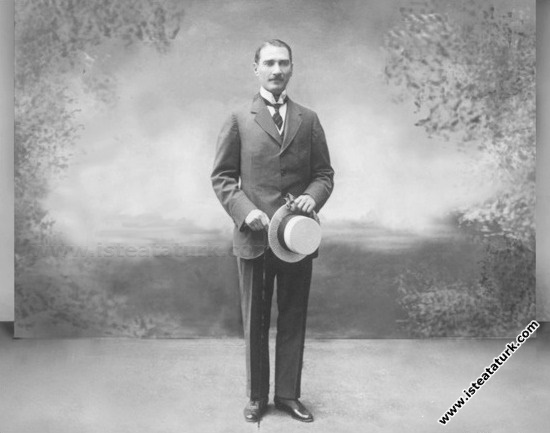
A Study on "Bayönder", The Theater Work About Atatürk
Character Size
A Study on "Bayönder", The Theater Work About Atatürk
A Study on “Bayönder”, The Theater Work About Atatürk
Summary
The aim of this study is to examine the drama called Bayönder, which is about Atatürk, and to determine the Republic's understanding of theater, the importance Atatürk gave to theater and what he expected from the theater. In addition, it is within the scope of this study to show how Atatürk's charismatic personality, with his own fiction, is reflected in a theater work, although not in terms of artistic value.
Entrance
“In Atatürk's eyes, theater is a synthesis of fine arts. It encompasses all of architecture, painting, literature and music. In this respect, theater is the real mirror of society. For this reason, special importance has been given to the art of theater.” (Kavcar, 1983:523)
The fact that the foundation of the theater of the Republic was laid on July 16, 1923, in the year the Republic was proclaimed, shows this. The most important educational institution for establishing a new era with the Republic and raising new people is the theater. That's why, thanks to Atatürk, theater became a national issue and the stage became a cultural platform.
Increasingly, the principles put forward about the works to be played in the theaters have also been determined. In works to be played in theaters;
"Love of the nation and homeland, enthusiasm for revolution, great moments of Turkish history, natural beauties of the country's big cities, towns and villages, bigotry and superstitions, ugliness of bad customs, high morality, happiness and the will to live" (Karpat, 1962:7) processing is required.
Atatürk, who gave special importance to fine arts and especially theater, intervened in the works written for the stage and even the works performed on the stage. The banning of Halit Fahri's Owl (1916), staged by the Ankara Teacher's School in the early years of the Republic, on stage while it was being staged, sets an example in this regard. one
In addition to the theater works that Atatürk was busy with while writing, there are also theater works that are about Atatürk himself. The first work in which Atatürk is the subject is Hayri Muhittin's three-act play Gazi Mustafa Kemal (1933). Many plays were written about Atatürk due to the War of Independence. Faruk Nafiz's Hero (1933), Reşat Nuri Güntekin's Istiklal (1933) and Aka Gündüz's Mavi Yıldırım (1934) are just a few of them. “Apart from these examples, besides the subject of the newly established Republic of Turkey, there are also works that indirectly draw parallels with Atatürk by addressing the old Turkish homeland, lineage and heroism.” (Önberk, 1982:90) Atatürk's preoccupation, his subject and development were determined with his directives;
In Bayönder, Atatürk wanted his own life to be briefly symbolized. For this reason, all the ideas in Bayönder were discussed separately. In addition, he wanted Bayönder to carry out the work, which he would do after the writing of the work, to leave his property to the party and the nation.
It will be useful and interesting to examine and evaluate Bayönder, who symbolizes Atatürk's life, was corrected three times by Atatürk and is desired to be repeated everywhere at all times, in terms of getting to know Atatürk and the basic ideas he instilled in his nation. We also hope that this examination and evaluation will give an idea about the essence and form of the theater that Atatürk wanted to establish.
BAYÖNDER
Bayönder is a verse theater work, the subject and development of which was determined by Atatürk and written by Münir Hayri Egeli. The work, which is an old Turkish irtaki (legend), consists of forty-five pages (one act and eight paintings) (Egeli, 1934). Within forty-five pages, it has been conceived as a work that can always be sought and played, claiming to represent a chief, a Bayönder, an Ata.
Subject of the Work
The subject of the work, as the name suggests, is Bayönder. The game includes the decor, the light, the people, etc. He tries to represent Bayönder's legendary personality with his features. Bayönder, who lost his wife on a stormy day, gifted his wealth to his nation and attained eternity after entrusting his ideal to the youth. Throughout the play, Bayönder's features and actions are dramatized. One of the characteristics of Bayönder is that he lived in an unknown Turkish age and an unknown Turkish nation, and, as repeated by Deli Ozan, is against the way of life and understanding of the society. The main conflict that is wanted to be revealed in the work is Bayönder's determination to bring a brand new understanding to his nation.
The understanding accepted by the nation is expressed by Deli Ozan as follows:
“Gönenç is a guest to us, as soon as it goes away
The heart does not easily take its bitter taste.
Gonenc doesn't drink the days like a renegade yar
As soon as prosperity passes from the heart like a crazy flood…” (Egeli, 1934:25)
Happiness is a guest in human life. It has a bitter taste. He is like a renegade lover. It drinks time, the bliss that is like a crazy flood is not good for people. This guest (happiness) is not permanent for long. Here, the world life and time tragedy of human beings have been identified. Likewise, happiness is an impermanent state for human beings. This is the basic view of the poet. But Bayönder opposes this understanding by silencing the entire choir:
“No, you are deceived. Prosperity is a good slave
This is his accident. Tear it, enter your ideal...
Prosperity is for us, prosperity cannot be a renegade...
The light of the bright eye cannot fade from the storm.” (Egeli, 1934:33)
Bayönder is a leader who leads the nation to the unity of the ideal by showing the way to make happiness and good slaves to his nation. The subject of the work, Bayönder, is a hero who brings happiness to his great nation, suggests that the light of the bright eye should not fade from the storm, and that the bright eye is an eye that does not care about even though it cries. (Egeli, 1934:37)
Bayonder is truly a hero. The reality he reveals for this world is summarized in the work as follows:
“Everyone is for an assignment, it comes and goes
Maybe he doesn't know what his debt is, he'll pay it off." (Egeli, 1934:41)
The task of the leaders is to fight the disasters of their nation, during the wars; What comes after him is to sacrifice all he has for his nation, who wholeheartedly participated in the ideal journey with its leaders.
He
For the theme of the work, it can be said that the sacrifice of the leaders is self-sacrifice. “It is the main duty of the leaders to fight the disasters of their nation and lead their nation to happiness. Leaders come to the world with the duty of sacrificing themselves for the salvation of their nation and they do their duty. From Kültigin to Atatürk, the leaders of the Turkish Nation are people who work to bring their nation to order, unity and solidarity, and to rise. With this belief and acceptance, leaders in the consciousness of being sent serve the rise of their nation and humanity, and they leave when the time comes.
Event Sequence
The play has a case of fourteen pages. Case takes place in an unknown age, in an unknown place. In the play, which claims to be the old Turkish irtekisi (legend), there is Ozan on the stage in the first painting. By stealing the cura in his hand;
“Listen, O guests, listen...
Ancestors are relics... I'm getting started hey. Lets...
he starts the game. In the second painting, there are Ozan, Bayönder, Bayan Izgen. Ozan is in the front, young Bayönder is on the side, and Mrs. Izgen is on the balcony. The poet continues his epic by telling how Bayönder and Bayan Izgen lived in the country in ancient times as the most suitable spouses for each other. Bayönder told Ms. Izgen, “What did you give me; Ülkü, believe, soul, horse (movement), we were born with you, you are both my body and my soul," he continues to offer his love. (Egeli, 1934:22) Izgen replied, "Women are men's flag of love." At the end of this happy painting, Ozan reads the quatrain that begins with "Gönenç is our guest, he will be gone soon". Ozan is accompanied by a grove of girls and boys.
After Ozan and the boys-girls grove, who foretell the disaster, Izgen is shaken, comes to the sofa in front, collapses. Seeing this, Bayönder runs and asks what happened. Izgen points to the storm outside and says that he is "commanded" to die on such a stormy day. (Egeli, 1934:25) He also repeats that Gönenç is a guest, that it will pass quickly, and that no happiness will be eternal. Bayonder does not believe it. Izgen is a gold bowl that he hides in his chest when he will die; He tells Bayönder that his heart is hidden in this bowl, and that he should take a sip with this bowl whenever he gets old. In addition, Izgen says that in the future there will be a big storm in the world, the day will turn into night, and the only person who will break this darkness is Bayönder. Miss Izgen dies.
In the third painting, Ozan continues to tell the audience his epic. He speaks to the choir. Tells the features and magnificence of Izgen.
Again, the chorus repeats that the bliss passes so quickly, that he is a guest who does not stay, but flows like a crazy flood.
In the fourth painting, Bayönder opposes the choir and the poet's view on happiness and makes it accepted by his actions: “Felicity is a good slave. Happiness is for us, happiness cannot be a renegade... The light of the bright eye cannot fade from the storm” (Egeli, 1934:33) Chorus and Bard join Bayönder and give him the right.
In the fifth painting, Bayönder orders the silent gentlemen to summon the greats of the country.
While the gentlemen summoned in the sixth painting arrive one by one, Ozan tells the audience that the bitter days are over, that the worries and worries have vanished, because Bayönder drank from the golden bowl. In Bayonder;
“What does the mad heart forget?
He cries, but does not care.” (Egeli, 1934:34).
In the seventh table, those who come gather together and wait for Bayönder's order. Bayönder orders the feast to begin. Chorus, boys, girls, everyone eats, drinks, has fun:
"Play your corner, hit the drummer, let the feast roof moan
Hit the strings, let the earth, the sky, the vast listen” (Egeli, 1934:37)
Bayönder tells the people there about the golden bowl and the death of Mrs. Izgen. Mentioning how he overcame disasters with the determination he took from this stone, Bayönder, gentlemen all at once;
“You threw a date
You created a history” (Egeli, 1934:41)
they express their love and respect. Thereupon, Bayonder;
“Everyone is for an assignment. Income goes
Maybe he doesn't know what the debt is, he just pays it." (Egeli, 1934:41)
After saying that, he explains why he called everyone and his wishes in his heart:
“There is moisture to spur you on, if there is no humidity, today,
I'm giving it to you.
I'm all yours
I'm laying out my place, my tent, before you."
Ozan asks for the golden bowl. Bayönder throws the golden bowl in his hand towards the vast sea by walking. An intellectual descends from the sky to the sea. The whole takes on a vast isolated appearance. Everyone is surprised and amazed. The poet explains the reason for the bowl thrown into the vastness:
“Golden bowl, your ideal
He told future generations:
Every day the Turk gets bored,
If he takes a sip of water from this vastness in his mouth,
It will be as if he drank from the edge of a golden horse.
The ancestral bowl will find its wish.” (Egeli, 1934:45)
In the seventh painting, Bayönder enters among the clouds. The stage goes slowly. The moon goes down, the night ends. As the colors of the sunrise begin, sons and daughters, the symbol of youth, emerge from the vastness from afar. Young people in unison;
“Our head is man, our body is plain fire.
Knowledge on our wrist, the sun envy us.
Our purse is gold, difficulty is our toy.
Our aim is to transcend the highest civilization as well.” (Egeli, 1934:45)
they adopt and repeat the ideal left by Bayönder.
laying
The series is performed in the first-second painting, with Ozan playing his Cura and starting to tell an old Turkish legend. However, the events displayed throughout the whole game are few in number. After the introduction of Bayönder and Mrs. İzgen, the idea that forms the basis of the play is immediately offered; happiness is a guest, it goes very quickly, it does not stay. However, this idea is immediately confirmed by the death of Mrs. Izgen, who is Bayönder's wife, the symbol of world goodness and human genius. Later, the understanding that Bayönder conflicts with and Bayönder's actions and suggestions are exhibited one after the other. However, in this work, events are shown and told at the same time. This attitude is the result of a missionary understanding and weakens the technical side of the drama.
Conflict
The conflict was initiated in the second painting of the work, which lasted quite a long time. Ozan sings that happiness is not permanent while Bayönder and Ms. İzgen are exhibiting their high happiness. The storm outside with the choir of girls and boys also heralds the disaster. The conflict in the work is the happiness of Bayönder and Mrs. İzgen and the shadow of death that falls on this happiness. Because Miss Izgen was ordered to die on a stormy night before. No life can go smoothly, completely happy. Here, a situation unique to almost every person has been brought into view, and this conflict has been given a universal identity. However, this conflict has lost its continuity as the hero transforms the conflict into harmony.
nodes
The main knot of the play is the death of Mrs. Izgen and the place and importance of Bayönder in the life of the nation, the golden bowl he gave to Bayönder. In addition, in the fifth painting, Bayönder invites the greats of the country to a feast by spreading news from all sides. It is also a matter of curiosity why this invitation was made. These two nodes continue until the end of the game. It can be said that the nodes are arranged according to the orientation of the main character of the game.
Two knots, Izgen's death, the meaning and importance of the golden bowl and Bayönder's purpose for the feast also determine the climax of the game. The solution in the game ends when Bayönder enters the clouds in the last table. The dissolution in the game begins with Bayönder's explanation of his purpose at the feast, which is integrated with the public.
Personification
Personalization is the essence of the game. The event cannot develop without the characters of the game. Theatre; reflects reality according to its own rules.”(Nutku, 1993:73) Of course, there is an obligation to choose, simplify and some abstractions in this reflection work. The author has to process the wishes and feelings of the person he is focusing on with precise lines. This is necessary so that the audience can understand that person. On behalf of a society, the author should reveal the people whom the society knows more or less incompletely, and should help everyone to be identified with clearer and more precise lines. In Bayönder, the main character is in the foreground. Events are arranged in a line that determines this person's personality and even what he will do in the future. The characters of the work are very few.
Bayonder:
Bayönder is intended to be dramatized as a legendary personality. The general characteristics of a person who is presented as a leader, founder, organizer and savior of a nation can be listed as follows:
1. Bayönder is young and strong. He is dressed as a demigod in a magnificently arranged scene. He is deeply attached to Ms. Izgen. He takes his belief, ideals, moves from Mrs. Izgen, who is the symbol of the world's goodness and human genius.
2. Bayönder encounters disaster in his life like every human being. But not pessimistic. He uses the memory he received from this death for the purpose and leads the nation to happiness. Because happiness continues in the life of the nation as a whole. Happiness is for the people. Happiness is the light of the shining eye. Bayönder is the symbol of continuing this light without extinguishing it.
3. Bayönder, who takes his nation to happiness, rises to the cloud of literature with the peace of doing his duty. He was sent to save his nation. He completed his duty and aimed the endless sea of happiness for the nation.
The personification of Bayönder, who was sent with the task of saving the nation from disasters and bringing happiness, has common aspects with the khans seen in the Orkhon Monuments. From beginning to end, the other characters in the game also represent an unknown Turkish age. Thus, the relationship with the beginning period of Turkish history is established.
4. There is no change in Bayönder from the beginning to the end of the game. He is a personality formed with definite lines. He is loved by his people, his command is awaited; sacrifices himself, his wealth and his life for the sake of his nation.
The most important point in the personification of Bayönder is to bring together the positive type of khan, ruler and sultan that has filtered from Turkish history. Indeed, the main lines of Bayönder's personality were synthesized from the rulers, the action men inherited from Kültigin to Fatih and Kanuni. Thus, in a way, the formation of a national culture through theatre, an example of a stylistic and meaningful life has been shown.
In addition, “The real face of the hero is tried to be shown in the work of art” (Oflazoğlu, 1985:13) In the personification of Bayönder, Atatürk's past deeds and future actions – his values that will stand against time – are presented in the form of a play on a stage. If history is one of the best forms of defense against the plunder of time, the other is the art of theatre. This is what is done in this personification. Because theater absorbs all the activities and products of individuals and nations and reflects them on the stage.
After İzgen:
Izgen personification in the game was also made in the legend environment. Izgen represented the ideal values of the nation with her beauty and the golden bowl she carried on her chest. It is the source of power and speed that Bayönder relies on. Rather than being a real personality, he is the representative of the nation's supreme values. She is not a woman who accompanies Bayönder for a long time. She is a person who constitutes the source of Bayönder and the literary ideal he presented to his nation. With Ms. Izgen, the Turk's desire for eternity was represented. The desire for eternity and the idea of freedom from the history of the Turkish nation seems to be represented in Izgen. The Turk's passion for eternity, represented by the vast seas, is the main source that saves him in difficult times.
Crazy Ozan:
He is a personality who reads the epic of his nation from the past to the future and interferes with the life of the nation in every era. The crazy Ozan, who conveys the life and past of his nation to the future, is the representative of the word. Deli Ozan, who has been expressing the values of the nation with his instrument for centuries, saves his nation from orphanhood. Deli Ozan, whom we see as the protector and preserver of the commonalities that make a nation a nation, is the person who keeps the cultural heritage alive and speaks (commands).
The shaping of the characters of the Bayönder play, the choir of boys and girls, and the whole public were performed in a magnificent setting. These personifications have been made with the help of all the elements in the game. This is necessary and important in terms of showing the integrity in every subject in the theater.
Language
Atatürk, who was very interested in Bayönder's personality, also meticulously focused on the language of the work. It was requested that Bayönder's language stay ahead of the language movement, which was very intense in those years, and that it be understandable with the language of tomorrow. The words used in conversations have been changed according to the place and situation in which they are used. The words male and female used today were decided for the first time when this game was written. In addition, instead of welcome, it was said that you brought a son, privates, and expressions such as to make people prosper, to gather the lights from the waters were included. In the text of the play, words such as cura, yangu, ezgi, andaç, bunn, kut, yeğint, command, nöker, peacock, dam, yaltırık, travel, yöş, döğme, siltav, cekli, atim, purpose, uygurluk, some of which are in our daily conversations, are used. The old equivalents of the words are also given at the bottom of the page.
The main text of the game (hauptext) is arranged in verse. The words that make up the main text have been chosen to evoke the cultural structure and events. (Efe, 1993:41) In this way, an effort is made to create a new culture.
The speech pattern in the text has the quality to feed the action on the stage. Each word invites another. In addition, there are many parts to support the words with nebentext, often in parentheses and at the beginning of the tables.
Dialogues indicate what the characters are and how they will act. In addition, the dialogues have been organized in an effort to explain and reflect the epic era in which people lived. The level of dialogue is seriously enhanced in the text. You already need to introduce the people of the game; it also necessitates the level of serious conversation that is suitable for those personalities. Because there are effective words and commands of an epic national savior in the game.
As a result, the language of the game was arranged in accordance with the attitudes of the people in the game, supported by the attitudes and became convincing. It can also be said that the dialogue is a determining factor for the characters of the play. However, the use of many new words in the dialogue, which we mentioned before, brought along the anxiety of not being understood by the audience.
Some Findings Under the Heading of Results
Bayönder play can be considered as a product of giving meaning and continuity to the existence of the personality it represents through art. In this respect, the game can be seen as a game in which historical and scientific reality predominates. However, the uneasiness of the dramatic structure in the play, in terms of form and substance, has not been abandoned.
In this short play of forty-five pages with its main and side texts and appendices, the requirements of the dramatic structure are adhered to. The integration of the play on the stage, all the elements that make up the play, are suitable for the dramatic structure. The theater elements, a poet narrator, the choir and the play characters, who are the representatives of the people since the ancient Greek theater, are suitable for the first dramatic structure form.
In the play, the poet undertakes the task of conveying the past to the ancestors from the past of the nation to the future. He does this as a member of the public who enters the midst of the people. Even though the poet does not do the job of directing as a man of speech, he succeeds in the task of voicing the acceptance of the people, of conveying what happened. The chief personification (Bayonder), who is seen as the reason for the writing of the play, is a man of action. This man of action has an epic personality that clashes with and changes the frozen mistakes of the people by listening to the suggestions of the man of speech or the public. This behavior conforms to the ideal man of action reality. In addition, it was tried to determine how the action man model should be and its features in the game.
As a man of action, Bayönder inculcates the following basic ideas with what he does and says:
1. The leader of a nation, a man of action, was sent for his people, to lead his people to happiness, peace, unity and solidarity:
“Everyone is for an assignment. Income goes
Maybe he doesn't know what the debt is, he only pays it." (Egeli, 1934:41)
2. A leader who has been sent to lead his nation to salvation must take his power from the goodness of the people, human values, and the supreme values in the essence of his nation. Bayönder takes a golden bowl from Izgenbegüm, who represents these values in the game, and drinks from it in every move that will lead his nation to happiness. Then he throws the golden bowl into the endless abyss. Thus, he eternalizes the lofty values that the golden bowl shows and ideally left to his nation. Ozan says:
“...
Every day the Turk gets bored,
If he takes a sip of water from this vastness in his mouth,
It will be as if he drank from the edge of a golden bowl,
The ancestral bowl will find its wish.” (Egeli, 1934:45)
3. A leader is a man who leaves what he has taken from his nation to his nation, and bequeaths his property, life and essence to his nation.
Bayönder fulfills his duties for his nation. It sends news from all sides, calls the greats of the country, leaves everything to its nation:
“Bayonder:
Since ages you
You walked behind me
You fought me
How many steep mountains did you cross,
You ran, you were thrown.
You wholeheartedly participated in this ideal trip.
There is moisture to make you happy, if there is no humidity today,
I'm giving it to you.
I'm all yours
I'm laying out my place, my tent, before you." (Egeli, 1934:41)
4. Leader plans his future and entrusts his ideals to the youth. Young people take the trust and make it their goal:
“Young people : (in unison)
.....................
Knowledge on our wrist, the sun envy us.
Our purse is gold, difficulty is our toy.
Our aim is to surpass the highest civilization (civilization)” (Egeli, 1934:45)
Considering these main ideas, it is possible to say that the play gives meaning and continuity to the existence of "Bayönder" in historical reality through art. Indeed, the values believed in the work have been realized through dramatization. Thus, the desired suggestions and communiqués were made to the whole nation on the stage. Today, if we accept that thought is more important than life, a step ahead of its time has been taken by giving importance to thought in this game.
Throughout the play, intellectual suggestions are made to a nation in the personification of Bayönder. The ideal of the nation is drawn towards the future. The values that should be found in the individuals of the nation have been determined as a series of main ideas. What the theater needs to do is “to ground the human existence by illuminating it or to illuminate it by grounding it.” (Oflazoglu, 1990:49)
The play called Bayönder is the result of the understanding of creating and developing national culture through theatre. It can be said that this play is the reflection of the same understanding of Atatürk, who not only directed the War of Independence, but also wrote the work called Speech against the plunder of time. One of the important reasons for Atatürk's value to the theater is that the theater is an art that was born as a result of the war of man and human race against the plunder of time. In addition, theater is perhaps the foremost among all cultural activities. Because theater is both a gain for the formation and development of national culture, and it reflects all our cultural yields from the past to the present by assimilating them. (Oflazoğlu, 1985:13-14) Atatürk, who conveyed to his nation the ideal of transforming his culture into the civilization of the world,
Assist. Assoc. Dr. Mustafa KIRCI*
* Ondokuz Mayıs University Faculty of Education
1 The information we received from Vâsık İnal, a student of Ankara Teacher's School in those years, and an art teacher at Samsun Education Institute, who witnessed the event personally.
Source
EFE, Fehmi. (1993). Drama Art, Istanbul: Yapi Kredi Publications.
EGELİ, M. Hayri. (1934). Bayonder Turkish Epic I. Act., Istanbul: Güneş Printing House.
KARPAT, Kemal. (1962). Social Issues in Turkish Literature, Istanbul: Varlık Publications.
KAVCAR, Cahit. (1983). Education in the Republic Period (“Fine Arts Education”), Istanbul : MEB Publishing House.
NUTKU, Ozdemir. (1993). Drama Art, Izmir.
OFLASOGLU, A. Turan. (1985). “History and Theatre”, Turkish Language, p. 397.
OFLASOGLU, A. Turan. (1990). “The Place of Thought in Theatre”, Turkish Language, p. 460.
ONBERK, Nevin. (1982). Atatürk and Culture (“Literature in the Republic Era”), Ankara : H.Ü. Publications Special Issue
